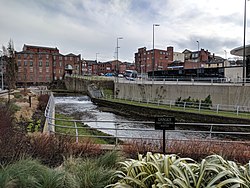River Roch
| River Roch | |
|---|---|
 Flowing in front of Rochdale Interchange and Number One Riverside | |
 | |
| Location | |
| Country | England |
| District | Littleborough, Rochdale, Heywood, Bury |
| Physical characteristics | |
| Source | |
| • location | Chelburn Moor |
| Mouth | |
• location | River Irwell, Radcliffe |
• coordinates | 53°33′43.95″N 2°18′2.65″W / 53.5622083°N 2.3007361°W |
| Length | 100 miles |
| Basin features | |
| Tributaries | |
| • left | Tack Lee Brook, Naden Brook, River Spodden, Hey Brook, Ash Brook, Featherstall Brook, Town House Brook |
| • right | Parr Brook, Hollins Brook, Wrigley Brook, Millers Brook, Sudden Brook, Moss Brook, Stanney Brook, River Beal, Ealees Brook, Greenvale Brook, Chelburn Brook |
River Roch | ||||||||||||||||||||||||||||||||||||||||||||||||||||||||||||||||||||||||||||||||||||||||||||||||||||||||||||||||||||||||||||||||||||||||||||||||||||||||||||||||||||||||||||||||||||||||||||||||||||||||||||||||||||||||||||||||||||||||||||||||||||||||||||||||||||||||||||||||||||||||||||||||||||||||||||||||||||||||||||||||||||||||||||||||||||||||||||||||||||||||||||||||||||||||||||||||||||||||||||||||||||||||||||||
|---|---|---|---|---|---|---|---|---|---|---|---|---|---|---|---|---|---|---|---|---|---|---|---|---|---|---|---|---|---|---|---|---|---|---|---|---|---|---|---|---|---|---|---|---|---|---|---|---|---|---|---|---|---|---|---|---|---|---|---|---|---|---|---|---|---|---|---|---|---|---|---|---|---|---|---|---|---|---|---|---|---|---|---|---|---|---|---|---|---|---|---|---|---|---|---|---|---|---|---|---|---|---|---|---|---|---|---|---|---|---|---|---|---|---|---|---|---|---|---|---|---|---|---|---|---|---|---|---|---|---|---|---|---|---|---|---|---|---|---|---|---|---|---|---|---|---|---|---|---|---|---|---|---|---|---|---|---|---|---|---|---|---|---|---|---|---|---|---|---|---|---|---|---|---|---|---|---|---|---|---|---|---|---|---|---|---|---|---|---|---|---|---|---|---|---|---|---|---|---|---|---|---|---|---|---|---|---|---|---|---|---|---|---|---|---|---|---|---|---|---|---|---|---|---|---|---|---|---|---|---|---|---|---|---|---|---|---|---|---|---|---|---|---|---|---|---|---|---|---|---|---|---|---|---|---|---|---|---|---|---|---|---|---|---|---|---|---|---|---|---|---|---|---|---|---|---|---|---|---|---|---|---|---|---|---|---|---|---|---|---|---|---|---|---|---|---|---|---|---|---|---|---|---|---|---|---|---|---|---|---|---|---|---|---|---|---|---|---|---|---|---|---|---|---|---|---|---|---|---|---|---|---|---|---|---|---|---|---|---|---|---|---|---|---|---|---|---|---|---|---|---|---|---|---|---|---|---|---|---|---|---|---|---|---|---|---|---|---|---|---|---|---|---|---|---|---|---|---|---|---|---|---|---|---|---|---|---|---|---|---|---|---|---|---|---|---|---|---|---|---|---|---|---|---|---|---|---|---|---|---|---|---|---|---|
| ||||||||||||||||||||||||||||||||||||||||||||||||||||||||||||||||||||||||||||||||||||||||||||||||||||||||||||||||||||||||||||||||||||||||||||||||||||||||||||||||||||||||||||||||||||||||||||||||||||||||||||||||||||||||||||||||||||||||||||||||||||||||||||||||||||||||||||||||||||||||||||||||||||||||||||||||||||||||||||||||||||||||||||||||||||||||||||||||||||||||||||||||||||||||||||||||||||||||||||||||||||||||||||||
The River Roch /ˈroʊtʃ/ is a river in Greater Manchester in North West England, a tributary of the River Irwell.
Course
Rising on Chelburn Moor (south of Todmorden in the Pennines), the river flows south through Littleborough towards Rochdale where it is joined by the River Beal at Belfield, and the River Spodden from Whitworth. Turning west it runs past Heywood and Bury before meeting the River Irwell just to the east of Radcliffe.
Etymology
The town of Rochdale is recorded as Recedham in the Domesday Book and Rachetham in 1193, with variations of Rechedham continuing into the thirteenth century.[1][2] It is thought that these names represent a pre-existing Brittonic name for the river Roch, borrowed into Old English for the name of the settlement.
The early forms of Rachet-ham and Reched-ham suggest a compound of two elements, ro-ced or ro-cet. The first element is either from the common intensive prefix rö- (Modern Welsh rhy-, Cornish re-) meaning "great" and found in other river names such as the Ribble and the Rother[3] or rag-, (Modern Welsh ar-) meaning "opposite" or "adjacent to".[4] The second element would then almost certainly be cę:d or cet, (Modern Welsh coed) meaning "wood".[5] This would give the name a meaning of "River of the great wood" or "River opposite the wood".
Another etymology focused on the early forms similarities to Rheged, the Cumbric-speaking kingdom in North West England during the Middle Ages.[6][7] Although this etymology is used to support the theory that the Roch may have been the centre of a separate kingdom known in Medieval Welsh literature as "South Rheged" or "Argoed" (opposite the wood), it remains unproven as the kingdom of Rheged's boundaries have not been identified.[8] A further suggestion is that the name "rheged" simply means "area" in the Cumbric language (related to Regio in Latin and Region in Modern English) and that the kingdom of Rheged and the river merely shared a common Celtic name.
Although Rochdale is pronounced /ˈrɒtʃdeɪl/ (with a shorter o sound), the name of the river is still pronounced /roʊtʃ/ (with a long vowel sound).
Later history
The river has been culverted in Rochdale town centre since the early 20th century. This was built by the joining together of seven bridges to form one large bridge, making it one of the widest bridges in the world. Maintenance work was carried out on the bridge in the 1990s and the river was uncovered temporarily.[9] In 2015 work began on opening the bridge again in a multimillion-pound project.[10] On Boxing Day 2015, following heavy rain, the Roch burst its banks causing flooding in the town centre.[11]
Tributaries
Moving upstream from the Irwell confluence, the tributaries include the following:
- Parr Brook
- Hollins Brook
- Whittle Brook
- Gigg Brook
- Barn Brook
- Green Brook
- Gipsy Brook
- Tack Lee Brook
- Wrigley Brook
- Naden Brook
- Plumpton Wood Brook
- Millers Brook
- Primrose Hill Brook
- Sudden Brook
- River Spodden
- Moss Brook
- Hey Brook
- Stanney Brook
- River Beal
- Ash Brook
- Clegg Hall Brook
- Wuerdle Brook
- Stubley Brook
- Featherstall Brook
- Ealees Brook
- Town House Brook
- Greenvale Brook
- Chelburn Brook
Gallery
- The source on Chelburn Moor
- Aqueduct across the Caldervale Railway
- Looking downstream from Smallbridge
- Confluence of River Beal
- Flowing under one of the world's widest bridges
- Confluence of River Spodden
- Upstream from Bottom o' th' Brow, Heywood
- Confluence with River Irwell
References
- ^ Mills, A.D.: A Dictionary of English Place Names, 2nd Edition, page 289, s.n. Rochdale. Oxford University Press, 1998
- ^ Ekwall, Eilert (1922). The Place-names of Lancashire. Manchester University Press. p. 54.
- ^ James, Alan G. "A Guide to the Place-Name Evidence – Guide to the Elements" (PDF). Scottish Place Name Society – The Brittonic Language in the Old North. Retrieved 25 October 2018.
- ^ James, Alan G. "A Guide to the Place-Name Evidence – Guide to the Elements" (PDF). Scottish Place Name Society – The Brittonic Language in the Old North. Retrieved 25 October 2018.
- ^ Clarkson, Tim (2012). The Men of the North : the Britons of Southern Scotland. Edinburgh: Birlinn. ISBN 978-1907909023.
- ^ Jackson, Kenneth (1953). Language & History in Early Britain. Edinburgh: Edinburgh University Press. p. 9.
- ^ Rollason, D. W. (2003). Northumbria, 500-1100 : Creation and Destruction of a Kingdom. Cambridge, UK: Cambridge University Press. p. 87. ISBN 0521813352.
- ^ Chadwick, Chadwick, Hector Munro, Nora Kershaw (1940) [1932]. The Growth of Literature (Volume II ed.). Cambridge: Cambridge University Press. p. 165.
{{cite book}}: CS1 maint: multiple names: authors list (link) - ^ "Link4Life | Covering the River Roch in Rochdale | Provider of arts, sport and heritage development work in the Rochdale area".
- ^ "Hidden medieval bridge reopens". BBC News. 14 June 2016. Retrieved 9 November 2017.
- ^ "Floods hit parts of UK amid downpours". BBC News. 27 December 2015.








